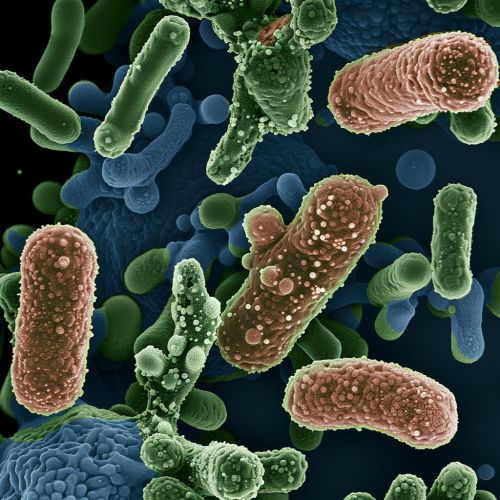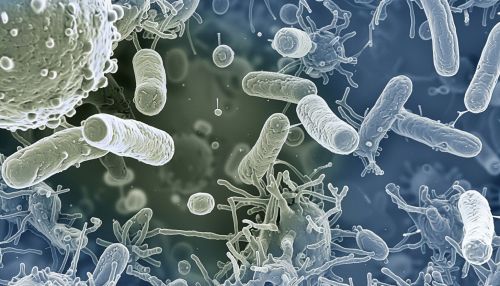Bacterial cell wall
Structure of the Bacterial Cell Wall
The bacterial cell wall is a complex and essential structure that provides shape, protection, and rigidity to bacterial cells. It is primarily composed of peptidoglycan, a polymer consisting of sugars and amino acids. The cell wall's composition and structure can vary significantly between different types of bacteria, leading to the classification of bacteria into two major groups: Gram-positive and Gram-negative.


Peptidoglycan Layer
The peptidoglycan layer is the main structural component of the bacterial cell wall. It is a mesh-like polymer that provides strength and rigidity. The peptidoglycan is composed of repeating units of N-acetylglucosamine (NAG) and N-acetylmuramic acid (NAM), which are cross-linked by short peptide chains. This structure forms a strong, protective layer around the bacterial cell.
The synthesis of peptidoglycan involves several key enzymes, including transglycosylases and transpeptidases, which catalyze the formation of glycosidic bonds and peptide cross-links, respectively. Inhibitors of these enzymes, such as beta-lactam antibiotics, can disrupt cell wall synthesis and lead to bacterial cell death.
Gram-Positive Bacteria
Gram-positive bacteria have a thick peptidoglycan layer, which can be up to 40 layers thick. This thick layer is responsible for retaining the crystal violet stain used in the Gram staining procedure, giving these bacteria their characteristic purple color. In addition to peptidoglycan, the cell wall of Gram-positive bacteria contains teichoic acids and lipoteichoic acids, which are polymers of glycerol or ribitol phosphate. These acids play a role in cell wall maintenance, ion transport, and regulation of autolytic enzymes.
The presence of teichoic acids also contributes to the overall negative charge of the cell surface, which can affect interactions with the environment and host immune responses.
Gram-Negative Bacteria
Gram-negative bacteria have a more complex cell wall structure compared to Gram-positive bacteria. Their cell wall consists of a thin peptidoglycan layer, located between the inner cytoplasmic membrane and an outer membrane. The outer membrane is an asymmetric bilayer composed of phospholipids, lipopolysaccharides (LPS), and proteins.
The LPS molecules, also known as endotoxins, are important for the structural integrity of the outer membrane and play a crucial role in the immune response of the host. The outer membrane also contains porins, which are protein channels that allow the passage of small molecules and ions.
The periplasmic space, located between the inner membrane and the outer membrane, contains various enzymes and proteins involved in nutrient acquisition, electron transport, and peptidoglycan synthesis.
Functions of the Bacterial Cell Wall
The bacterial cell wall serves several critical functions, including:
- **Shape and Structural Integrity:** The cell wall maintains the shape of the bacterium and prevents it from bursting due to osmotic pressure.
- **Protection:** It provides a protective barrier against environmental stresses, such as changes in osmotic pressure, desiccation, and mechanical damage.
- **Pathogenicity:** Components of the cell wall, such as LPS in Gram-negative bacteria and teichoic acids in Gram-positive bacteria, can act as virulence factors and trigger immune responses in the host.
- **Selective Permeability:** The cell wall, particularly the outer membrane in Gram-negative bacteria, regulates the entry and exit of substances, contributing to the selective permeability of the bacterial cell.
Variations in Bacterial Cell Walls
While the Gram-positive and Gram-negative classifications cover the majority of bacteria, there are notable exceptions and variations in cell wall structure:
Acid-Fast Bacteria
Acid-fast bacteria, such as Mycobacterium species, have a unique cell wall structure that contains a high concentration of mycolic acids. These long-chain fatty acids form a waxy, hydrophobic layer that makes the cell wall impermeable to many stains and antibiotics. The acid-fast staining technique, which uses carbolfuchsin and acid-alcohol, is used to identify these bacteria.
Mycoplasma
Mycoplasma species lack a cell wall entirely, making them unique among bacteria. Instead, they have a flexible cell membrane that contains sterols, which provide structural support and protection. The absence of a cell wall makes Mycoplasma resistant to antibiotics that target cell wall synthesis, such as beta-lactams.
Archaea
Although not bacteria, archaea have cell walls that differ significantly from those of bacteria. Archaeal cell walls lack peptidoglycan and instead contain pseudopeptidoglycan, polysaccharides, or proteins. The composition and structure of archaeal cell walls vary widely among different species.
Biosynthesis and Regulation of the Cell Wall
The biosynthesis of the bacterial cell wall is a highly regulated process that involves multiple steps and enzymes. The key stages of peptidoglycan synthesis include:
- **Precursor Synthesis:** In the cytoplasm, NAG and NAM are synthesized and linked to a pentapeptide chain.
- **Transport:** The lipid carrier bactoprenol transports the peptidoglycan precursors across the cytoplasmic membrane.
- **Polymerization:** Transglycosylases polymerize the NAG-NAM units into long glycan chains.
- **Cross-Linking:** Transpeptidases cross-link the peptide chains to form a strong, mesh-like structure.
Regulation of cell wall synthesis is crucial for bacterial growth and division. Autolysins, enzymes that degrade peptidoglycan, play a role in cell wall remodeling and separation of daughter cells during cell division. The balance between synthesis and degradation of peptidoglycan is tightly controlled to maintain cell wall integrity.
Antibiotic Targeting of the Cell Wall
The bacterial cell wall is a major target for antibiotics due to its essential role in bacterial survival. Several classes of antibiotics target different stages of cell wall synthesis:
- **Beta-Lactams:** These antibiotics, including penicillins and cephalosporins, inhibit transpeptidases, preventing the cross-linking of peptidoglycan chains.
- **Glycopeptides:** Vancomycin and teicoplanin bind to the D-Ala-D-Ala terminus of peptidoglycan precursors, blocking their incorporation into the cell wall.
- **Bacitracin:** This antibiotic interferes with the dephosphorylation of bactoprenol, inhibiting the transport of peptidoglycan precursors across the cytoplasmic membrane.
The emergence of antibiotic resistance, such as the production of beta-lactamases and alterations in target sites, poses a significant challenge in the treatment of bacterial infections. Understanding the mechanisms of cell wall synthesis and regulation is crucial for developing new antibiotics and combating resistance.
